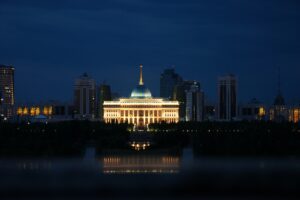
Wild horses return to Kazakh steppes
In a historic effort to restore the steppes of Central Kazakhstan, Przewalski’s horses, the world’s last remaining wild horse species, have returned to their native habitat after nearly 200 years. This remarkable event marks a significant milestone in global conservation efforts and the restoration of Kazakhstan’s unique ecosystems.
The reintroduction project, initiated by a coalition of European zoos and conservation organizations, aims to establish a self-sustaining population of Przewalski’s horses in the Altyn Dala region. The first group of eight horses, consisting of three stallions and five mares, arrived in Arkalyk on June 4th, 2024, following a meticulously planned journey from Prague and Berlin. These horses will be the foundation of what is expected to be a 40-strong population within the next five years.
The Przewalski’s horse, named after Russian explorer Nikolai Przhevalsky, was driven to extinction in the wild by the late 1960s due to habitat loss and hunting. However, the species survived in captivity, with conservation efforts led by institutions such as Prague Zoo, which has been pivotal in breeding and managing the global population of these horses. All existing Przewalski’s horses today descend from just 12 wild-caught individuals.
The journey to reintroduce these horses involved complex logistics and international collaboration. The horses were transported by the Czech Army’s CASA C-295M aircraft, with stopovers in Istanbul and Baku before reaching their final destination. Upon arrival, they were taken to the Alibi Reintroduction and Acclimatization Center in the Altyn Dala reserve, where they will undergo a period of acclimatization before being released into the wild.
This reintroduction is part of the broader Altyn Dala Conservation Initiative, which aims to restore the steppe, semi-desert, and desert ecosystems across an area of approximately 750,000 square kilometers—an expanse more than twice the size of Germany. The initiative focuses on reestablishing the region’s native megafauna, including the Przewalski’s horses, the Asiatic wild ass (Kulan), and the Saiga antelope, which are crucial for maintaining the ecological balance.
The significance of this project extends beyond the reintroduction of a single species. Przewalski’s horses play a vital role in the steppe ecosystem as ecosystem engineers. Their grazing patterns help maintain grassland diversity, prevent desertification, and support other wildlife by facilitating access to water and exposing food sources during harsh winters. These activities are essential for the resilience of the steppe ecosystem against environmental challenges like wildfires and climate change.
Kazakhstan’s Minister of Ecology and Natural Resources, Yerlan Nyssanbayev, hailed the project as a critical step in the country’s conservation efforts. “The return of Przewalski’s horses to the Kazakh steppe is a significant milestone in our ongoing efforts to conserve and restore Kazakhstan’s unique ecosystems,” Nyssanbayev said during the official ceremony in Arkalyk.

